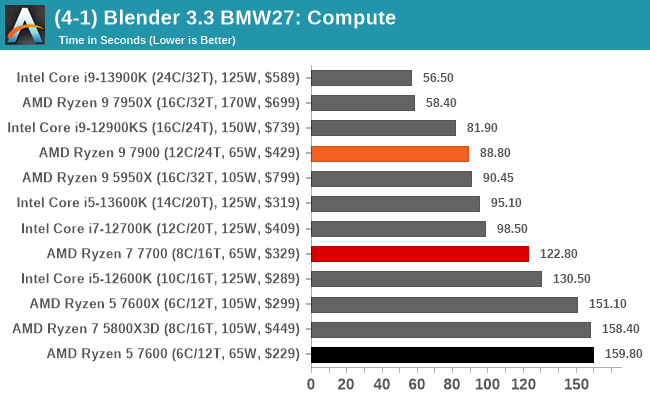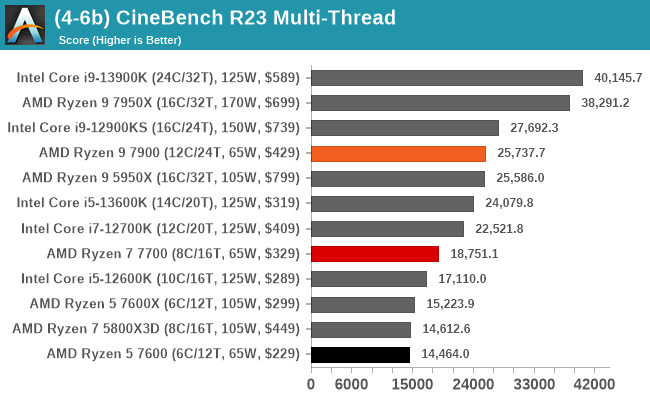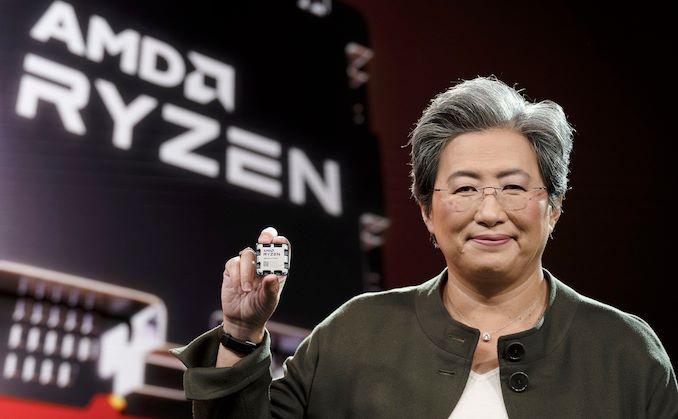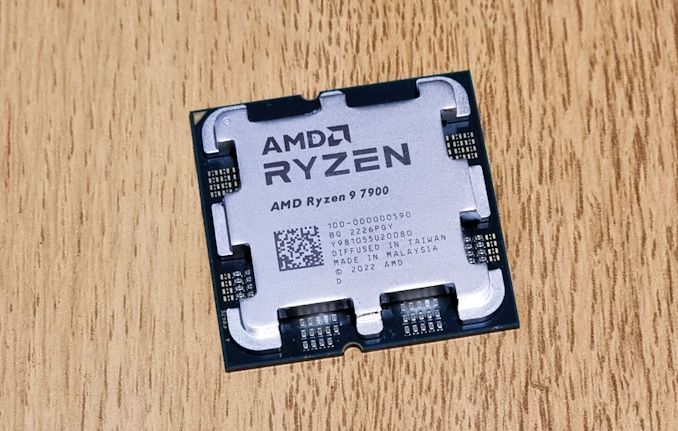The AMD Ryzen 9 7900, Ryzen 7 7700, and Ryzen 5 7600 Review: Zen 4 Efficiency at 65 Watts
by Gavin Bonshor on January 9, 2023 9:00 AM ESTConclusion
Ever since we reviewed the Ryzen 9 7950X and Ryzen 5 7600X processors back in September, it was clear that AMD had a solid architecture on their hands with Zen 4, as it showed double-digit improvements to performance over the Ryzen 5000 (Zen 3) series. Although the Ryzen 9 7950X showed inherently higher levels of power consumption and core temperatures in comparison to the Ryzen 9 5950X, AMD's design choice by opting to boost cores up to high frequencies such as 5.7 GHz is one that was worth implementing to maximize outright performance. But that doesn't mean Zen 4 is a one-trick pony.
With the Ryzen 7000 65 W family, AMD is looking to change the dynamic that users need to consume oodles of power to achieve high levels of performance. To do that, they're launching three SKUs, including the Ryzen 9 7900 (12C/24T), Ryzen 7 7700 (8C/16), and Ryzen 5 7600 (6C/12T).
Along similar lines, we recently looked at how the AMD Ryzen 9 7950X and Intel Core i9-13900K scale when adjusting the Power Package Tracking (PPT) and Thermal Design Power (TDP) to lower levels, to see how much limiting power to the cores has on overall performance. When it comes to AMD, the overall consensus of our CPU power scaling results showed that AMD's Zen 4 core architecture is very efficient, even at lower power levels. So it's easy to see why AMD has released 65 W SKUs based on its ability to deliver leading performance-per-watt efficiency than it ever has previously. That was, of course, with the Ryzen 9 7950X, which is a 16-core and 32-thread part, but does all of that efficiency translate when shaving off some of those cores and threads?
Ryzen 7000 at 65 W: Performance Analysis
Diving into how the Ryzen 9 7900 ($429), Ryzen 7 7700 ($329), and the Ryzen 5 7600 ($229) performed in our updated CPU suite, we were pretty impressed with the overall performance on offer, despite being limited to a 65 TDP limit. Although power consumption on the CPU package was around 90 W at full load, this is still considerably lower than other processors the trio of 65 W Ryzen 7000 chips was pitted against.

Taking one of our results in Blender 3.3 as an example (BMW27), we can see that the AMD Ryzen 7900 performs better than the Ryzen 9 5950X, even at 65 W. This is superb performance-per-watt efficiency compared to the previous generation, especially given it's 12C/24T at 65 W versus 16C/32T Zen 3 at 105/140W. In the case of the Ryzen 7 7700, it still performed well and sat between the Intel Alder Lake 12th Gen Core i5-12600K and Core i7-12700K; despite conceding power, cores, and threads all around.
Looking at the entry-level six-core part, the Ryzen 5 7600, the lack of cores, threads, and power, the combination of the three did take the legs away from it a little bit, especially in heavy multi-threaded workloads.

While single-threaded performance isn't much of a concern due to the superior levels of IPC performance with AMD's 5nm-fabbed Zen 4 core, multi-threaded performance isn't as detrimental to the Ryzen 5 7600 as going from 105 W to 65 W may seem. In CineBench R23's multi-threaded test, the Ryzen 5 7600 at 65 W and the Ryzen 5 7600X (105 W) are rather comparable in overall performance. There's a minor performance hit, but not enough to make it black and white.
Looking at the Ryzen 9 7900, it marginally beats out the Ryzen 9 5950X and sits just below the Intel Core i9-12900KS, a power-hungry yet very rapid top-of-the-range desktop processor from last year. The Ryzen 7 7700 again sits between the Core i7 and Core i5 K-series Alder Lake (12th Gen) processors.

Turning our attention to gaming performance, all three AMD Ryzen 7000 65 W SKUs perform well at 1080, 1440p, and 4K resolutions. Of course, the key to this performance is using a top-tier graphics card such as the Radeon RX 6950 XT, but the performance is still notably good. All three AMD models perform consistently well in Borderlands 3 at 1080p maximum settings despite being limited to 65 W TDPs.
This tells us that the CPU performance from Zen 4 at 65 W, even with fewer cores than other chips on test, is powerful enough for AAA titles when paired with a high-performing graphics card. Of course, users on a budget may want to pair up a Ryzen 5 7600 with a card such as an AMD Radeon RTX 6600, and it's going to be a different proposition to what we're testing with, but we test with an RX 6960 XT for parity in our results.
Closing Thoughts: Ryzen 7000 at 65 W is Highly Efficient
For a budget gaming PC, the Ryzen 5 7600 ($229) is an interesting proposition when paired up with a B650 motherboard and an affordable pair of DDR5 memory sticks, such as Corsair's Vengeance 32 GB (2 x 16 GB) kit. Intel also has its own 13th Gen Core 65 W series processors coming to the market, with similar pricing on a core-to-thread count basis with AMDs. The advantage of AMD's Ryzen 7000 65 W SKUs is that they are unlocked, so users can overclock them and squeeze out additional performance. The disadvantage is that the Ryzen 7000 series is only compatible with DDR5 memory. In contrast, Raptor Lake supports DDR5 and DDR4, which must be factored in for users on a stringent budget.

AMD CEO Dr. Lisa Su presented the Ryzen 7000 series back in September 2022
From a performance perspective, the Ryzen 9 7900 and Ryzen 7 7700 are shooting it out with processors with more expensive MSRPs, which also adds to the value proposition. In terms of power efficiency, all of the Ryzen 7000 65 W SKUs shows incredible performance, despite being power limited and running at 100 W under maximum load, at least from our experience in testing them.
If video editing, content creation, and rendering are desired, and performance is critical, the Ryzen 9 7950X is the go-to chip if AM5 is essential, but the Ryzen 9 7900 competes in gaming. It's cheaper while still offering solid performance in compute-heavy workloads. The Ryzen 9 7900 loses out in raw compute power against the flagship bearing Ryzen 9 7950X, but the Ryzen 9 7900 uses much less energy to achieve what we think is a solid level of performance.
Another avenue offering additional value to users is AMD has bundled coolers with each of the three Ryzen 7000 65 W CPUs. Included with the Ryzen 9 7900 and Ryzen 7 7700 is AMD's Wrath Prism cooler with RGB LED lighting that can be customized via AMD's Wraith Prism LED software. The entry-level Ryzen 5 7600 is an AMD Wraith Stealth cooler, which is smaller by design and practical to keep the CPU cool under load, but without the pizazz of RGB. Bundling coolers with its more affordable CPUs means users can spend their budget on a premium AIO cooler through better memory, storage, or graphics, which will have a positive impact on performance.
Overall, AMD and the Ryzen 9 7900 ($429), Ryzen 7 7700 ($329), and Ryzen 5 7600 ($229) all represent different propositions to users looking for a solid low-powered desktop processor to build a system with. They also represent different levels within the market, including the entry-level with the Ryzen 5 7600, the mid-range with the Ryzen 7 7700, and the middle to high-end of the market with the Ryzen 9 7900. All three produce the goods, even at 65 W in terms of performance-per-watt efficiency, and it's good to see that AMD doesn't just kick it at the higher-end (Ryzen 9 7950X); it also proves Zen 4 can deliver the goods in power-limited situations too.
The levels of efficiency with Zen 4 at 65 W are awe-inspiring, but the next step on the Zen 4 train is Ryzen 7000 X3D, which is due sometime in February. How its 3D L3 V-Cache laden chips deliver is an entirely different proposition, but one we look forward to seeing pan out in real-time.











55 Comments
View All Comments
The Von Matrices - Monday, January 9, 2023 - link
The multiple tests where the 7900 is beating the 7950X by large (>5%) differences in game tests makes no sense and makes me concerned for the repeatability of the test suite. There is nothing (cache, clock speed, architecture, TDP, NUMA) that is inferior on the 7950X compared to the 7900 but somehow it loses by a large margin in many game tests.ag10n - Monday, January 9, 2023 - link
in your conclusion "Of course, users on a budget may want to pair up a Ryzen 5 7600 with a card such as an AMD Radeon RTX 6600"no RTX on the 6600 afaik ;)
boozed - Monday, January 9, 2023 - link
Those power consumption numbers are amazing.While you can make the argument that a "65W" AMD CPU consuming 90W is misleading, at least it's going to be consistently 90W regardless of which model you choose...
thulle - Monday, January 9, 2023 - link
Doesn't it become really weird to talk about efficiency while only comparing to TDP and not actual power consumption for the load? Not everything hits TTP as yCruncher does either.Preferrably the score in each result should be normalized to actual power consumption, or something similar. Even that has its issues though, since the balance between performance and efficiency is somewhat tuneable.
t.s - Monday, January 16, 2023 - link
Seconded! Or write the AVG power for the task. Ex: Cinebench: 7950X (214W) xxx.xxx pointHarry_Wild - Monday, January 9, 2023 - link
Performance difference is not that much! I going with the 7600 for internet surfing, watching streaming videos and email!😁👍LuxZg - Tuesday, January 10, 2023 - link
I was expecting that all along, so I'm glad it's confirmed. Now just to find sensible AM5 MBO at the right price :-/James5mith - Tuesday, January 10, 2023 - link
Real question: Why do CPUs no longer idle in the 800MHz-1600MHz range? Is there too great a change in the multiplier to hit max turbo at this point? Otherwise, what's the point at idling around 3.6GHz?It seems like a waste of power.
qwertymac93 - Tuesday, January 10, 2023 - link
The cores are gated such that they are at 0hz when idle. The clock shown in Windows is just the speed the core ran at when it last reported.fallaha56 - Tuesday, January 10, 2023 - link
Goodness Anandtech do better, ditch the bizarre memory policy and do some PBO testing…